Nursing Care Plans for Wound Patients
VerifiedAdded on 2020/11/23
|13
|4297
|480
Project
AI Summary
This assignment focuses on the elements first-year nursing students include in their care plans for patients with acute or chronic wounds. It delves into topics such as ostomy/wound management, the impact of undone nursing care on patient outcomes, collaboration between nurses and patients in care planning, and the practical aspects of carrying out the nursing process. The assignment also considers factors influencing nurse work environments and how they affect patient outcomes.
Contribute Materials
Your contribution can guide someone’s learning journey. Share your
documents today.
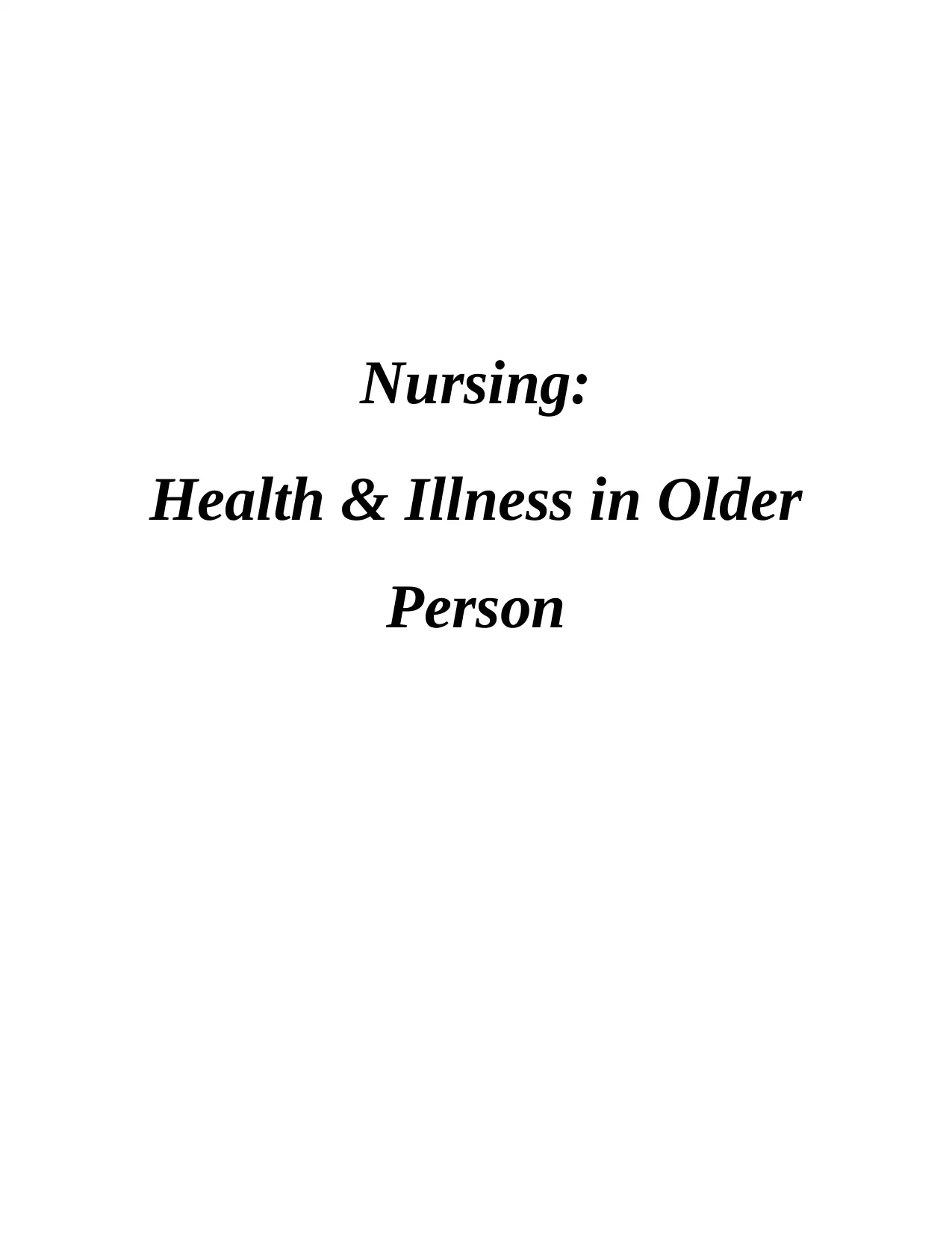
Nursing:
Health & Illness in Older
Person
Health & Illness in Older
Person
Secure Best Marks with AI Grader
Need help grading? Try our AI Grader for instant feedback on your assignments.

TABLE OF CONTENTS
INTRODUCTION...........................................................................................................................1
PART 1............................................................................................................................................1
Write a Case Study.................................................................................................................1
PART 2............................................................................................................................................3
Develop a plan of care for Mr. William Martin. ...................................................................3
CONCLUSION................................................................................................................................7
REFERENCES................................................................................................................................1
INTRODUCTION...........................................................................................................................1
PART 1............................................................................................................................................1
Write a Case Study.................................................................................................................1
PART 2............................................................................................................................................3
Develop a plan of care for Mr. William Martin. ...................................................................3
CONCLUSION................................................................................................................................7
REFERENCES................................................................................................................................1
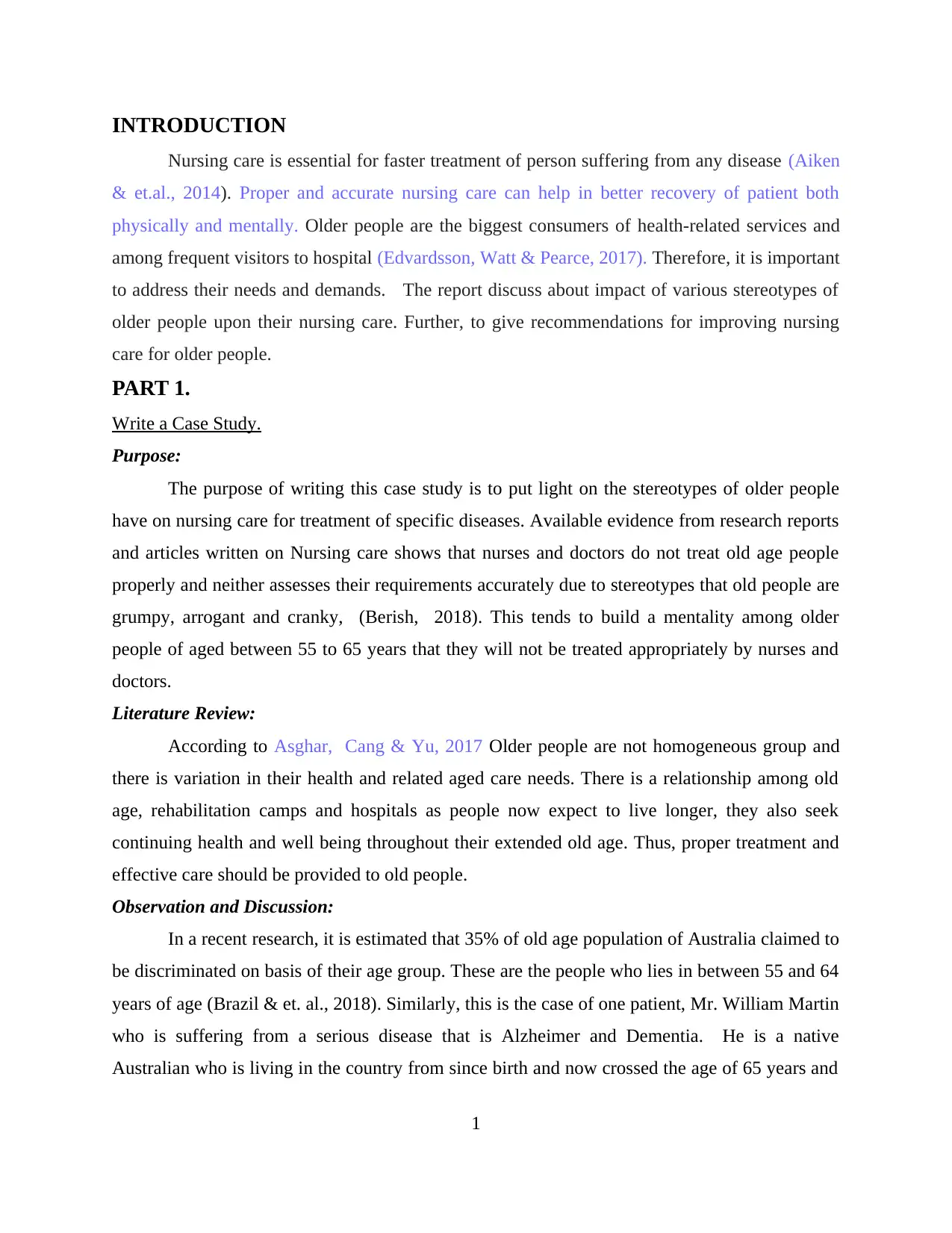
INTRODUCTION
Nursing care is essential for faster treatment of person suffering from any disease (Aiken
& et.al., 2014). Proper and accurate nursing care can help in better recovery of patient both
physically and mentally. Older people are the biggest consumers of health-related services and
among frequent visitors to hospital (Edvardsson, Watt & Pearce, 2017). Therefore, it is important
to address their needs and demands. The report discuss about impact of various stereotypes of
older people upon their nursing care. Further, to give recommendations for improving nursing
care for older people.
PART 1.
Write a Case Study.
Purpose:
The purpose of writing this case study is to put light on the stereotypes of older people
have on nursing care for treatment of specific diseases. Available evidence from research reports
and articles written on Nursing care shows that nurses and doctors do not treat old age people
properly and neither assesses their requirements accurately due to stereotypes that old people are
grumpy, arrogant and cranky, (Berish, 2018). This tends to build a mentality among older
people of aged between 55 to 65 years that they will not be treated appropriately by nurses and
doctors.
Literature Review:
According to Asghar, Cang & Yu, 2017 Older people are not homogeneous group and
there is variation in their health and related aged care needs. There is a relationship among old
age, rehabilitation camps and hospitals as people now expect to live longer, they also seek
continuing health and well being throughout their extended old age. Thus, proper treatment and
effective care should be provided to old people.
Observation and Discussion:
In a recent research, it is estimated that 35% of old age population of Australia claimed to
be discriminated on basis of their age group. These are the people who lies in between 55 and 64
years of age (Brazil & et. al., 2018). Similarly, this is the case of one patient, Mr. William Martin
who is suffering from a serious disease that is Alzheimer and Dementia. He is a native
Australian who is living in the country from since birth and now crossed the age of 65 years and
1
Nursing care is essential for faster treatment of person suffering from any disease (Aiken
& et.al., 2014). Proper and accurate nursing care can help in better recovery of patient both
physically and mentally. Older people are the biggest consumers of health-related services and
among frequent visitors to hospital (Edvardsson, Watt & Pearce, 2017). Therefore, it is important
to address their needs and demands. The report discuss about impact of various stereotypes of
older people upon their nursing care. Further, to give recommendations for improving nursing
care for older people.
PART 1.
Write a Case Study.
Purpose:
The purpose of writing this case study is to put light on the stereotypes of older people
have on nursing care for treatment of specific diseases. Available evidence from research reports
and articles written on Nursing care shows that nurses and doctors do not treat old age people
properly and neither assesses their requirements accurately due to stereotypes that old people are
grumpy, arrogant and cranky, (Berish, 2018). This tends to build a mentality among older
people of aged between 55 to 65 years that they will not be treated appropriately by nurses and
doctors.
Literature Review:
According to Asghar, Cang & Yu, 2017 Older people are not homogeneous group and
there is variation in their health and related aged care needs. There is a relationship among old
age, rehabilitation camps and hospitals as people now expect to live longer, they also seek
continuing health and well being throughout their extended old age. Thus, proper treatment and
effective care should be provided to old people.
Observation and Discussion:
In a recent research, it is estimated that 35% of old age population of Australia claimed to
be discriminated on basis of their age group. These are the people who lies in between 55 and 64
years of age (Brazil & et. al., 2018). Similarly, this is the case of one patient, Mr. William Martin
who is suffering from a serious disease that is Alzheimer and Dementia. He is a native
Australian who is living in the country from since birth and now crossed the age of 65 years and
1

presented in hospital for critical diseases of old age. Mr. William is vulnerable and denied taking
treatment.
Alzheimer's is chronic diseases in which there is progressive mental deterioration that can
occur in old age. It falls under the category of dementia and is a common condition where brain
is no longer able to functions properly (Bramley & Matiti., 2014). Dementia is a syndrome and it
can be controlled through medication and its symptoms can be treated On the other side there is a
lack of medical treatment to stop progressing of Alzheimer. Mr. William Martin is among the
10% population who is near to death due to chronic disease like Alzheimer's. He lives alone in
Western Australia in his small house and he is suffering from this disease for past 6 years. Due to
his Alzheimer's Mr. William has met with an accident two years before and broken down his left
leg and hand. Martin was reported with four fractures in his hand and leg for which he was
treated by putting rods to support his muscles.
Mr. William Martin was hospitalized for eight days because of its critical condition due
to progressing Alzheimer and therefore he was under the observation of doctors. Nurses and
doctors are not giving an accurate care to Martin due to stereotype build for old age people that
they are cranky and annoying. Many nurses in acute care setting had little, specialist education in
care and treatment of older people and therefore fails to understand their needs and issues. This
results in improper treatment of old people and they are deprived of basic demands. Doctors are
not willing to take care of old age people and they avoid addressing him due to stereotype
developed for old age people. He is suffering from chronic disease which requires a careful and
proper treatment along with timely checking and monitoring of his health outcome. Nurses do
not report on time to check and monitor about condition of Mr. William. When Mr. William met
with an accident he was presented in hospital and it was diagnosed that his both hand and leg
were fractured. There is a drastic change reported in health of Mr. William and improper
treatment by hospital has made his condition even more worse. This kind of behavior by nurse
has affected his ability to do daily routine work which made his life more miserable.
Conclusion and Recommendation.
Recent environmental changes which affect old age people:
Social development and ageist stereotypes has affected people of aged population like
Mr. William Martin. It has significantly influenced health care system (Giger, 2016). Older
people are perceived by policy makers and society in general as their problems require
2
treatment.
Alzheimer's is chronic diseases in which there is progressive mental deterioration that can
occur in old age. It falls under the category of dementia and is a common condition where brain
is no longer able to functions properly (Bramley & Matiti., 2014). Dementia is a syndrome and it
can be controlled through medication and its symptoms can be treated On the other side there is a
lack of medical treatment to stop progressing of Alzheimer. Mr. William Martin is among the
10% population who is near to death due to chronic disease like Alzheimer's. He lives alone in
Western Australia in his small house and he is suffering from this disease for past 6 years. Due to
his Alzheimer's Mr. William has met with an accident two years before and broken down his left
leg and hand. Martin was reported with four fractures in his hand and leg for which he was
treated by putting rods to support his muscles.
Mr. William Martin was hospitalized for eight days because of its critical condition due
to progressing Alzheimer and therefore he was under the observation of doctors. Nurses and
doctors are not giving an accurate care to Martin due to stereotype build for old age people that
they are cranky and annoying. Many nurses in acute care setting had little, specialist education in
care and treatment of older people and therefore fails to understand their needs and issues. This
results in improper treatment of old people and they are deprived of basic demands. Doctors are
not willing to take care of old age people and they avoid addressing him due to stereotype
developed for old age people. He is suffering from chronic disease which requires a careful and
proper treatment along with timely checking and monitoring of his health outcome. Nurses do
not report on time to check and monitor about condition of Mr. William. When Mr. William met
with an accident he was presented in hospital and it was diagnosed that his both hand and leg
were fractured. There is a drastic change reported in health of Mr. William and improper
treatment by hospital has made his condition even more worse. This kind of behavior by nurse
has affected his ability to do daily routine work which made his life more miserable.
Conclusion and Recommendation.
Recent environmental changes which affect old age people:
Social development and ageist stereotypes has affected people of aged population like
Mr. William Martin. It has significantly influenced health care system (Giger, 2016). Older
people are perceived by policy makers and society in general as their problems require
2
Secure Best Marks with AI Grader
Need help grading? Try our AI Grader for instant feedback on your assignments.
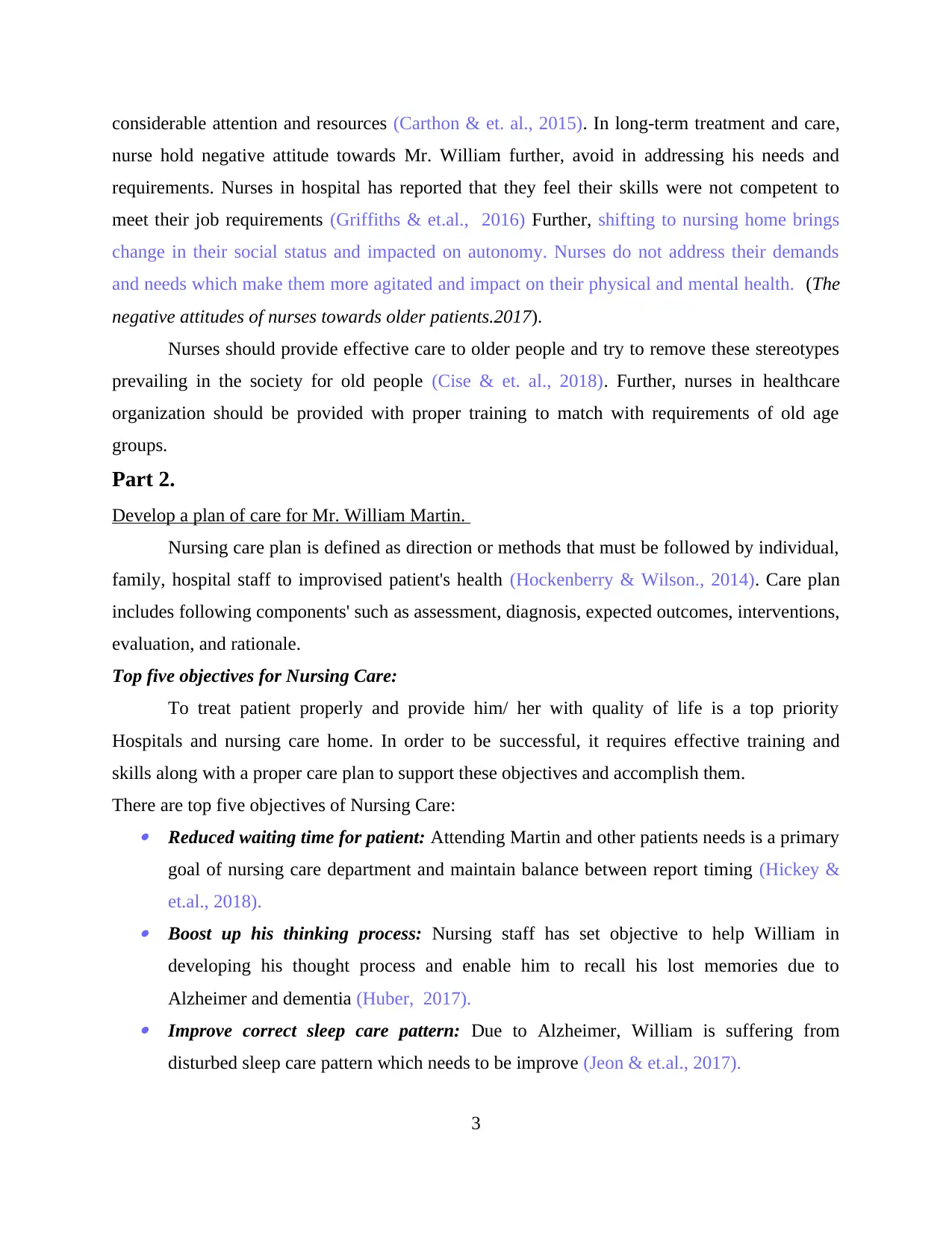
considerable attention and resources (Carthon & et. al., 2015). In long-term treatment and care,
nurse hold negative attitude towards Mr. William further, avoid in addressing his needs and
requirements. Nurses in hospital has reported that they feel their skills were not competent to
meet their job requirements (Griffiths & et.al., 2016) Further, shifting to nursing home brings
change in their social status and impacted on autonomy. Nurses do not address their demands
and needs which make them more agitated and impact on their physical and mental health. (The
negative attitudes of nurses towards older patients.2017).
Nurses should provide effective care to older people and try to remove these stereotypes
prevailing in the society for old people (Cise & et. al., 2018). Further, nurses in healthcare
organization should be provided with proper training to match with requirements of old age
groups.
Part 2.
Develop a plan of care for Mr. William Martin.
Nursing care plan is defined as direction or methods that must be followed by individual,
family, hospital staff to improvised patient's health (Hockenberry & Wilson., 2014). Care plan
includes following components' such as assessment, diagnosis, expected outcomes, interventions,
evaluation, and rationale.
Top five objectives for Nursing Care:
To treat patient properly and provide him/ her with quality of life is a top priority
Hospitals and nursing care home. In order to be successful, it requires effective training and
skills along with a proper care plan to support these objectives and accomplish them.
There are top five objectives of Nursing Care: Reduced waiting time for patient: Attending Martin and other patients needs is a primary
goal of nursing care department and maintain balance between report timing (Hickey &
et.al., 2018). Boost up his thinking process: Nursing staff has set objective to help William in
developing his thought process and enable him to recall his lost memories due to
Alzheimer and dementia (Huber, 2017). Improve correct sleep care pattern: Due to Alzheimer, William is suffering from
disturbed sleep care pattern which needs to be improve (Jeon & et.al., 2017).
3
nurse hold negative attitude towards Mr. William further, avoid in addressing his needs and
requirements. Nurses in hospital has reported that they feel their skills were not competent to
meet their job requirements (Griffiths & et.al., 2016) Further, shifting to nursing home brings
change in their social status and impacted on autonomy. Nurses do not address their demands
and needs which make them more agitated and impact on their physical and mental health. (The
negative attitudes of nurses towards older patients.2017).
Nurses should provide effective care to older people and try to remove these stereotypes
prevailing in the society for old people (Cise & et. al., 2018). Further, nurses in healthcare
organization should be provided with proper training to match with requirements of old age
groups.
Part 2.
Develop a plan of care for Mr. William Martin.
Nursing care plan is defined as direction or methods that must be followed by individual,
family, hospital staff to improvised patient's health (Hockenberry & Wilson., 2014). Care plan
includes following components' such as assessment, diagnosis, expected outcomes, interventions,
evaluation, and rationale.
Top five objectives for Nursing Care:
To treat patient properly and provide him/ her with quality of life is a top priority
Hospitals and nursing care home. In order to be successful, it requires effective training and
skills along with a proper care plan to support these objectives and accomplish them.
There are top five objectives of Nursing Care: Reduced waiting time for patient: Attending Martin and other patients needs is a primary
goal of nursing care department and maintain balance between report timing (Hickey &
et.al., 2018). Boost up his thinking process: Nursing staff has set objective to help William in
developing his thought process and enable him to recall his lost memories due to
Alzheimer and dementia (Huber, 2017). Improve correct sleep care pattern: Due to Alzheimer, William is suffering from
disturbed sleep care pattern which needs to be improve (Jeon & et.al., 2017).
3
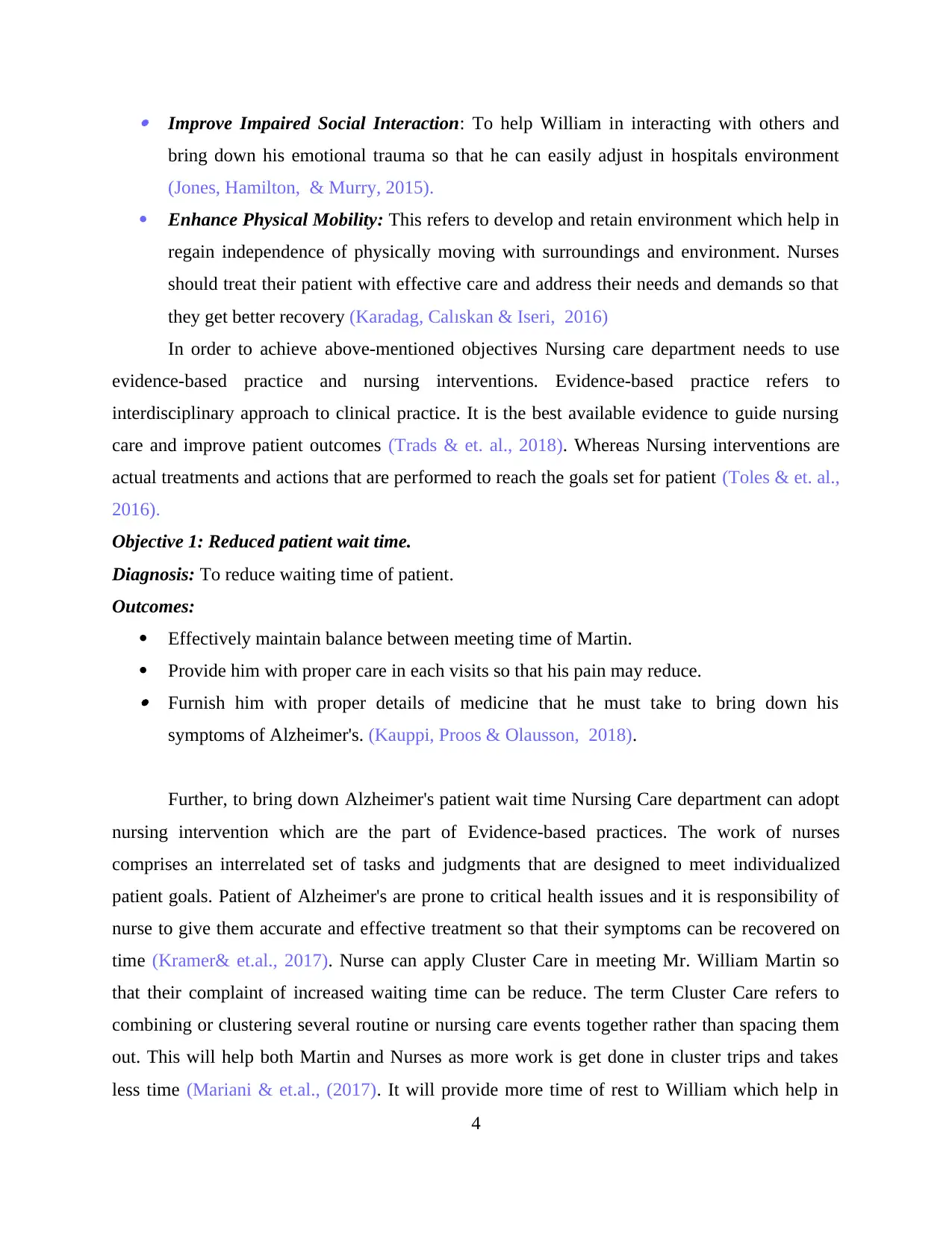
Improve Impaired Social Interaction: To help William in interacting with others and
bring down his emotional trauma so that he can easily adjust in hospitals environment
(Jones, Hamilton, & Murry, 2015).
Enhance Physical Mobility: This refers to develop and retain environment which help in
regain independence of physically moving with surroundings and environment. Nurses
should treat their patient with effective care and address their needs and demands so that
they get better recovery (Karadag, Calıskan & Iseri, 2016)
In order to achieve above-mentioned objectives Nursing care department needs to use
evidence-based practice and nursing interventions. Evidence-based practice refers to
interdisciplinary approach to clinical practice. It is the best available evidence to guide nursing
care and improve patient outcomes (Trads & et. al., 2018). Whereas Nursing interventions are
actual treatments and actions that are performed to reach the goals set for patient (Toles & et. al.,
2016).
Objective 1: Reduced patient wait time.
Diagnosis: To reduce waiting time of patient.
Outcomes:
Effectively maintain balance between meeting time of Martin.
Provide him with proper care in each visits so that his pain may reduce. Furnish him with proper details of medicine that he must take to bring down his
symptoms of Alzheimer's. (Kauppi, Proos & Olausson, 2018).
Further, to bring down Alzheimer's patient wait time Nursing Care department can adopt
nursing intervention which are the part of Evidence-based practices. The work of nurses
comprises an interrelated set of tasks and judgments that are designed to meet individualized
patient goals. Patient of Alzheimer's are prone to critical health issues and it is responsibility of
nurse to give them accurate and effective treatment so that their symptoms can be recovered on
time (Kramer& et.al., 2017). Nurse can apply Cluster Care in meeting Mr. William Martin so
that their complaint of increased waiting time can be reduce. The term Cluster Care refers to
combining or clustering several routine or nursing care events together rather than spacing them
out. This will help both Martin and Nurses as more work is get done in cluster trips and takes
less time (Mariani & et.al., (2017). It will provide more time of rest to William which help in
4
bring down his emotional trauma so that he can easily adjust in hospitals environment
(Jones, Hamilton, & Murry, 2015).
Enhance Physical Mobility: This refers to develop and retain environment which help in
regain independence of physically moving with surroundings and environment. Nurses
should treat their patient with effective care and address their needs and demands so that
they get better recovery (Karadag, Calıskan & Iseri, 2016)
In order to achieve above-mentioned objectives Nursing care department needs to use
evidence-based practice and nursing interventions. Evidence-based practice refers to
interdisciplinary approach to clinical practice. It is the best available evidence to guide nursing
care and improve patient outcomes (Trads & et. al., 2018). Whereas Nursing interventions are
actual treatments and actions that are performed to reach the goals set for patient (Toles & et. al.,
2016).
Objective 1: Reduced patient wait time.
Diagnosis: To reduce waiting time of patient.
Outcomes:
Effectively maintain balance between meeting time of Martin.
Provide him with proper care in each visits so that his pain may reduce. Furnish him with proper details of medicine that he must take to bring down his
symptoms of Alzheimer's. (Kauppi, Proos & Olausson, 2018).
Further, to bring down Alzheimer's patient wait time Nursing Care department can adopt
nursing intervention which are the part of Evidence-based practices. The work of nurses
comprises an interrelated set of tasks and judgments that are designed to meet individualized
patient goals. Patient of Alzheimer's are prone to critical health issues and it is responsibility of
nurse to give them accurate and effective treatment so that their symptoms can be recovered on
time (Kramer& et.al., 2017). Nurse can apply Cluster Care in meeting Mr. William Martin so
that their complaint of increased waiting time can be reduce. The term Cluster Care refers to
combining or clustering several routine or nursing care events together rather than spacing them
out. This will help both Martin and Nurses as more work is get done in cluster trips and takes
less time (Mariani & et.al., (2017). It will provide more time of rest to William which help in
4
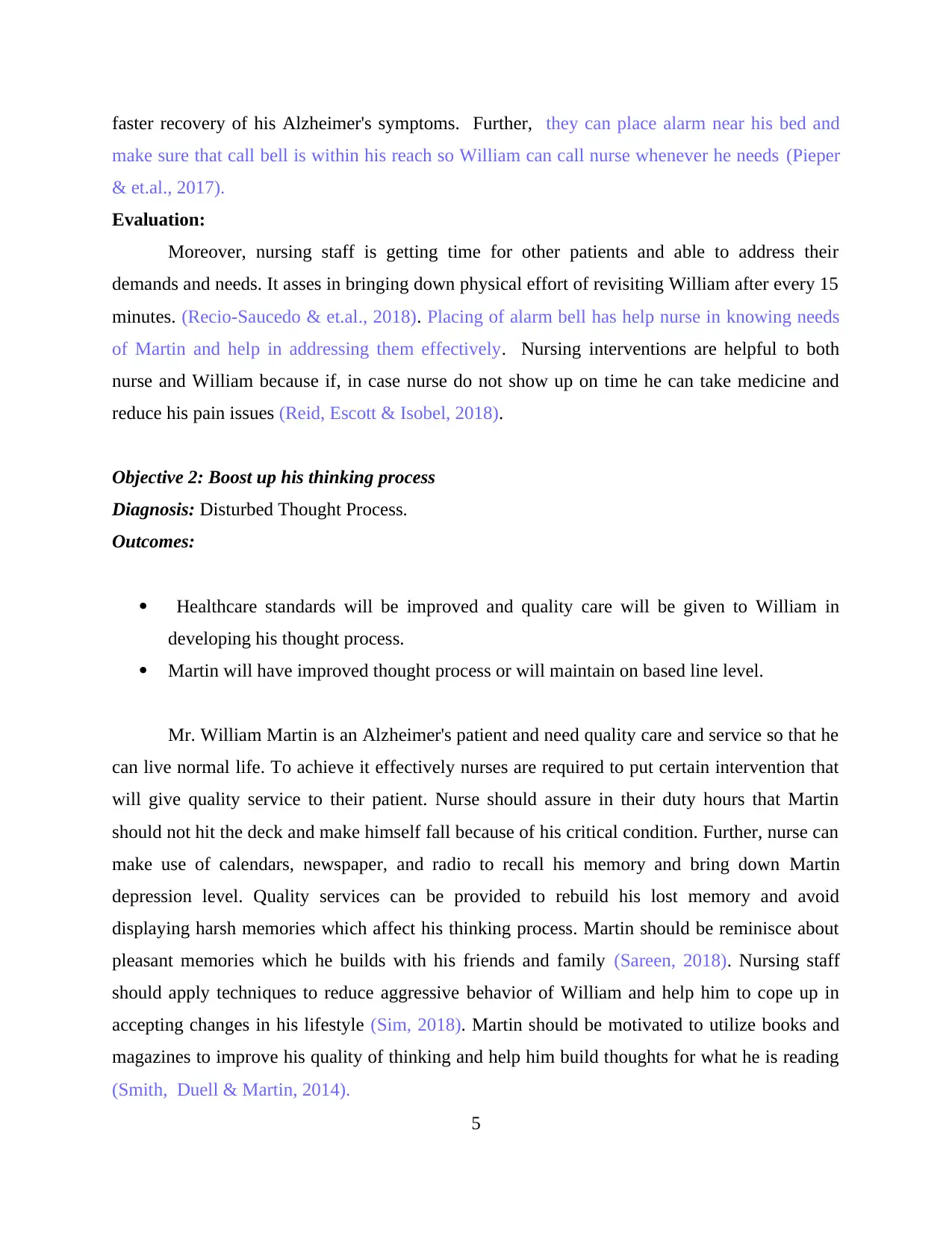
faster recovery of his Alzheimer's symptoms. Further, they can place alarm near his bed and
make sure that call bell is within his reach so William can call nurse whenever he needs (Pieper
& et.al., 2017).
Evaluation:
Moreover, nursing staff is getting time for other patients and able to address their
demands and needs. It asses in bringing down physical effort of revisiting William after every 15
minutes. (Recio‐Saucedo & et.al., 2018). Placing of alarm bell has help nurse in knowing needs
of Martin and help in addressing them effectively. Nursing interventions are helpful to both
nurse and William because if, in case nurse do not show up on time he can take medicine and
reduce his pain issues (Reid, Escott & Isobel, 2018).
Objective 2: Boost up his thinking process
Diagnosis: Disturbed Thought Process.
Outcomes:
Healthcare standards will be improved and quality care will be given to William in
developing his thought process.
Martin will have improved thought process or will maintain on based line level.
Mr. William Martin is an Alzheimer's patient and need quality care and service so that he
can live normal life. To achieve it effectively nurses are required to put certain intervention that
will give quality service to their patient. Nurse should assure in their duty hours that Martin
should not hit the deck and make himself fall because of his critical condition. Further, nurse can
make use of calendars, newspaper, and radio to recall his memory and bring down Martin
depression level. Quality services can be provided to rebuild his lost memory and avoid
displaying harsh memories which affect his thinking process. Martin should be reminisce about
pleasant memories which he builds with his friends and family (Sareen, 2018). Nursing staff
should apply techniques to reduce aggressive behavior of William and help him to cope up in
accepting changes in his lifestyle (Sim, 2018). Martin should be motivated to utilize books and
magazines to improve his quality of thinking and help him build thoughts for what he is reading
(Smith, Duell & Martin, 2014).
5
make sure that call bell is within his reach so William can call nurse whenever he needs (Pieper
& et.al., 2017).
Evaluation:
Moreover, nursing staff is getting time for other patients and able to address their
demands and needs. It asses in bringing down physical effort of revisiting William after every 15
minutes. (Recio‐Saucedo & et.al., 2018). Placing of alarm bell has help nurse in knowing needs
of Martin and help in addressing them effectively. Nursing interventions are helpful to both
nurse and William because if, in case nurse do not show up on time he can take medicine and
reduce his pain issues (Reid, Escott & Isobel, 2018).
Objective 2: Boost up his thinking process
Diagnosis: Disturbed Thought Process.
Outcomes:
Healthcare standards will be improved and quality care will be given to William in
developing his thought process.
Martin will have improved thought process or will maintain on based line level.
Mr. William Martin is an Alzheimer's patient and need quality care and service so that he
can live normal life. To achieve it effectively nurses are required to put certain intervention that
will give quality service to their patient. Nurse should assure in their duty hours that Martin
should not hit the deck and make himself fall because of his critical condition. Further, nurse can
make use of calendars, newspaper, and radio to recall his memory and bring down Martin
depression level. Quality services can be provided to rebuild his lost memory and avoid
displaying harsh memories which affect his thinking process. Martin should be reminisce about
pleasant memories which he builds with his friends and family (Sareen, 2018). Nursing staff
should apply techniques to reduce aggressive behavior of William and help him to cope up in
accepting changes in his lifestyle (Sim, 2018). Martin should be motivated to utilize books and
magazines to improve his quality of thinking and help him build thoughts for what he is reading
(Smith, Duell & Martin, 2014).
5
Paraphrase This Document
Need a fresh take? Get an instant paraphrase of this document with our AI Paraphraser
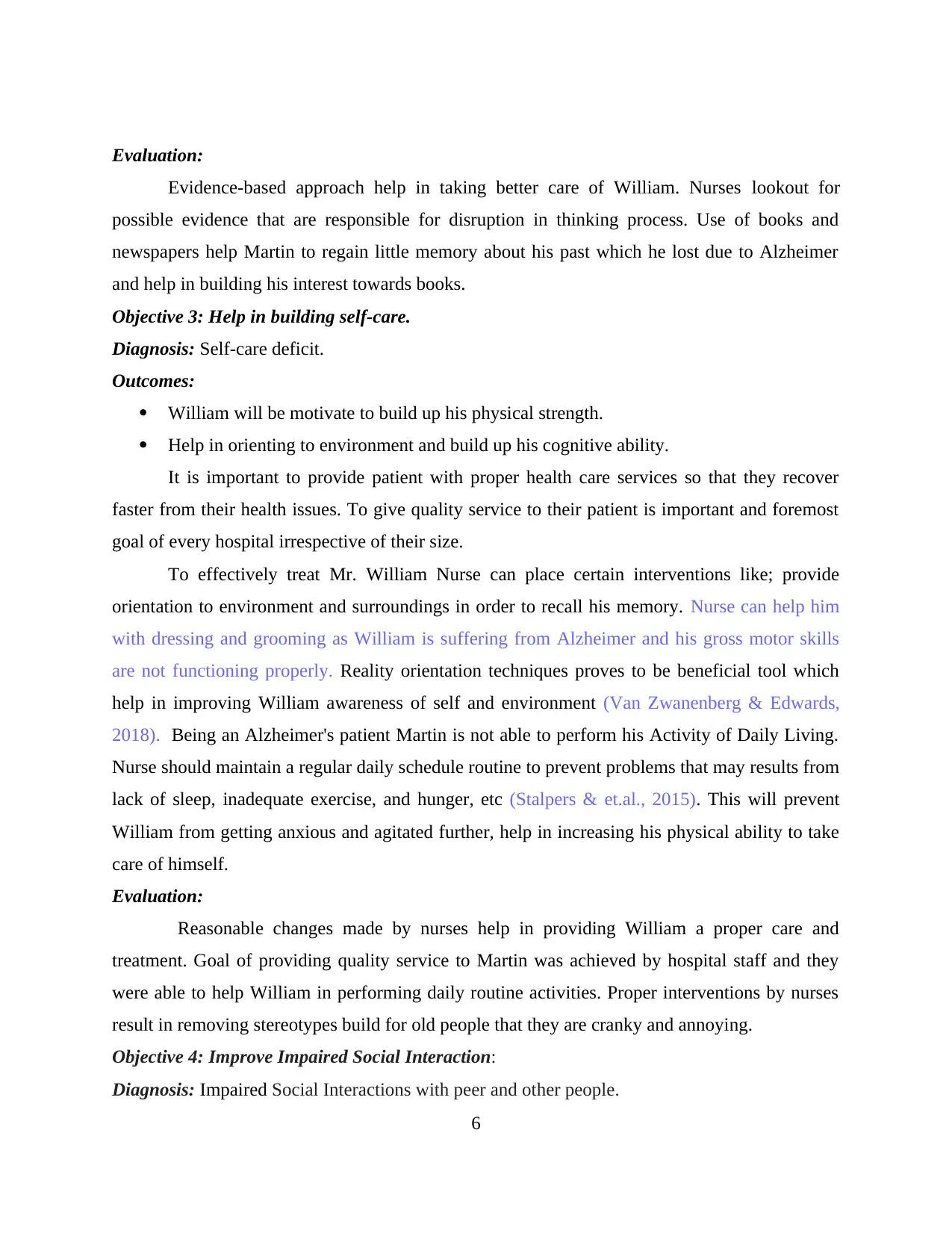
Evaluation:
Evidence-based approach help in taking better care of William. Nurses lookout for
possible evidence that are responsible for disruption in thinking process. Use of books and
newspapers help Martin to regain little memory about his past which he lost due to Alzheimer
and help in building his interest towards books.
Objective 3: Help in building self-care.
Diagnosis: Self-care deficit.
Outcomes:
William will be motivate to build up his physical strength.
Help in orienting to environment and build up his cognitive ability.
It is important to provide patient with proper health care services so that they recover
faster from their health issues. To give quality service to their patient is important and foremost
goal of every hospital irrespective of their size.
To effectively treat Mr. William Nurse can place certain interventions like; provide
orientation to environment and surroundings in order to recall his memory. Nurse can help him
with dressing and grooming as William is suffering from Alzheimer and his gross motor skills
are not functioning properly. Reality orientation techniques proves to be beneficial tool which
help in improving William awareness of self and environment (Van Zwanenberg & Edwards,
2018). Being an Alzheimer's patient Martin is not able to perform his Activity of Daily Living.
Nurse should maintain a regular daily schedule routine to prevent problems that may results from
lack of sleep, inadequate exercise, and hunger, etc (Stalpers & et.al., 2015). This will prevent
William from getting anxious and agitated further, help in increasing his physical ability to take
care of himself.
Evaluation:
Reasonable changes made by nurses help in providing William a proper care and
treatment. Goal of providing quality service to Martin was achieved by hospital staff and they
were able to help William in performing daily routine activities. Proper interventions by nurses
result in removing stereotypes build for old people that they are cranky and annoying.
Objective 4: Improve Impaired Social Interaction:
Diagnosis: Impaired Social Interactions with peer and other people.
6
Evidence-based approach help in taking better care of William. Nurses lookout for
possible evidence that are responsible for disruption in thinking process. Use of books and
newspapers help Martin to regain little memory about his past which he lost due to Alzheimer
and help in building his interest towards books.
Objective 3: Help in building self-care.
Diagnosis: Self-care deficit.
Outcomes:
William will be motivate to build up his physical strength.
Help in orienting to environment and build up his cognitive ability.
It is important to provide patient with proper health care services so that they recover
faster from their health issues. To give quality service to their patient is important and foremost
goal of every hospital irrespective of their size.
To effectively treat Mr. William Nurse can place certain interventions like; provide
orientation to environment and surroundings in order to recall his memory. Nurse can help him
with dressing and grooming as William is suffering from Alzheimer and his gross motor skills
are not functioning properly. Reality orientation techniques proves to be beneficial tool which
help in improving William awareness of self and environment (Van Zwanenberg & Edwards,
2018). Being an Alzheimer's patient Martin is not able to perform his Activity of Daily Living.
Nurse should maintain a regular daily schedule routine to prevent problems that may results from
lack of sleep, inadequate exercise, and hunger, etc (Stalpers & et.al., 2015). This will prevent
William from getting anxious and agitated further, help in increasing his physical ability to take
care of himself.
Evaluation:
Reasonable changes made by nurses help in providing William a proper care and
treatment. Goal of providing quality service to Martin was achieved by hospital staff and they
were able to help William in performing daily routine activities. Proper interventions by nurses
result in removing stereotypes build for old people that they are cranky and annoying.
Objective 4: Improve Impaired Social Interaction:
Diagnosis: Impaired Social Interactions with peer and other people.
6

Outcomes:
William will be motivated to improve his social interactions with peer groups and nursing
staff of hospital.
Activities will be used to boost up his social interactions with others.
Nursing interventions can be used to bring back the lost social interaction of William with others
and help in coping or adjusting with current environment of hospital. Nurses should assess and
improve Martin ability to cope with events, build up his interests in surroundings and motivate
him to actively participate in activities and events take place to encourage elderly people (Westra
& et.al., 2015). Speech therapy proves to be very effective in raising his social interaction with
other patients and this will assess in improving the relationship between Nursing care department
and William (Whitehead & Myers, 2016). William should be encouraged to take participation in
activities like; gardening, leisure and cultural activities, sports events organize for elderly people.
Further, he should be motivated to interact with his peer groups and share his feelings and issues
of life.
Evaluation:
Behavior of William is improved and he has started interacting with his fellow patient.
Further, he uses gestures like shaking hand with nursing staff and address them in a polite and
humble tone. Nursing intervention help Martin to easily cope up with the changes in his lifestyle.
Objective 5: Enhance Physical Mobility:
Diagnosis: Impaired Physical Mobility.
Desired Outcomes:
Maintain position of function and regain mobility at highest possible level. Increase strength/function of affected and compensatory parts of Martin.
William has encountered with an accident 2 years before which has impacted on his
physical mobility and reduces his ability to cope with his physical environment. Nurse should
provide Martin with range of exercise in every shift they make this will help in preventing joint
contractures. Provide enough time to perform mobility where Martin can make use of his energy
and build up his sense of self-control. Further, nursing care department of hospitals and doctors
can encourage use of isometric exercise starting from unaffected limb (Xiao & et.al., 2017).
To reduce his pain and to cure his impairment nurse should be involved in providing
William with healthy diet, to plan his sleeping patterns properly. Further, they should monitor
7
William will be motivated to improve his social interactions with peer groups and nursing
staff of hospital.
Activities will be used to boost up his social interactions with others.
Nursing interventions can be used to bring back the lost social interaction of William with others
and help in coping or adjusting with current environment of hospital. Nurses should assess and
improve Martin ability to cope with events, build up his interests in surroundings and motivate
him to actively participate in activities and events take place to encourage elderly people (Westra
& et.al., 2015). Speech therapy proves to be very effective in raising his social interaction with
other patients and this will assess in improving the relationship between Nursing care department
and William (Whitehead & Myers, 2016). William should be encouraged to take participation in
activities like; gardening, leisure and cultural activities, sports events organize for elderly people.
Further, he should be motivated to interact with his peer groups and share his feelings and issues
of life.
Evaluation:
Behavior of William is improved and he has started interacting with his fellow patient.
Further, he uses gestures like shaking hand with nursing staff and address them in a polite and
humble tone. Nursing intervention help Martin to easily cope up with the changes in his lifestyle.
Objective 5: Enhance Physical Mobility:
Diagnosis: Impaired Physical Mobility.
Desired Outcomes:
Maintain position of function and regain mobility at highest possible level. Increase strength/function of affected and compensatory parts of Martin.
William has encountered with an accident 2 years before which has impacted on his
physical mobility and reduces his ability to cope with his physical environment. Nurse should
provide Martin with range of exercise in every shift they make this will help in preventing joint
contractures. Provide enough time to perform mobility where Martin can make use of his energy
and build up his sense of self-control. Further, nursing care department of hospitals and doctors
can encourage use of isometric exercise starting from unaffected limb (Xiao & et.al., 2017).
To reduce his pain and to cure his impairment nurse should be involved in providing
William with healthy diet, to plan his sleeping patterns properly. Further, they should monitor
7
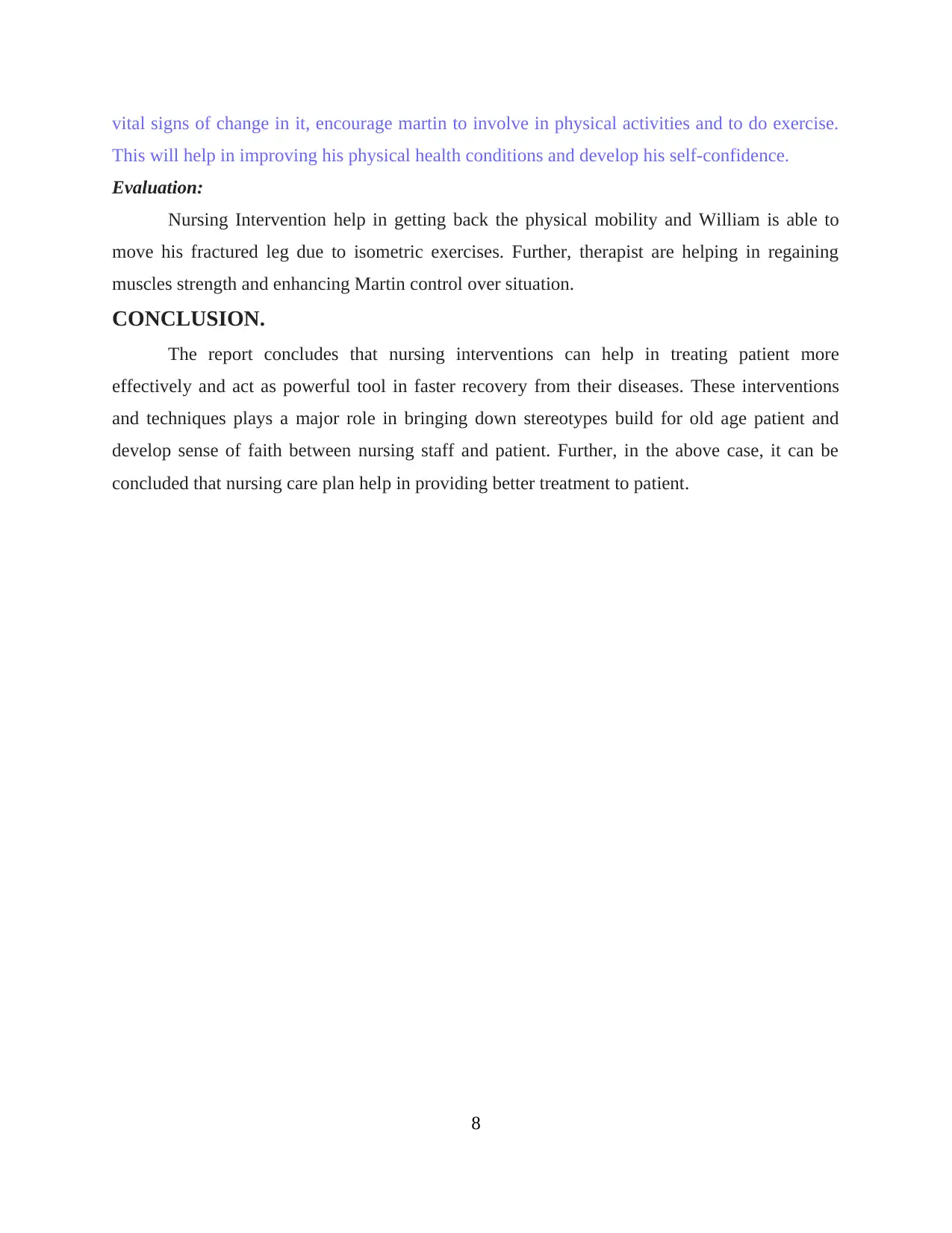
vital signs of change in it, encourage martin to involve in physical activities and to do exercise.
This will help in improving his physical health conditions and develop his self-confidence.
Evaluation:
Nursing Intervention help in getting back the physical mobility and William is able to
move his fractured leg due to isometric exercises. Further, therapist are helping in regaining
muscles strength and enhancing Martin control over situation.
CONCLUSION.
The report concludes that nursing interventions can help in treating patient more
effectively and act as powerful tool in faster recovery from their diseases. These interventions
and techniques plays a major role in bringing down stereotypes build for old age patient and
develop sense of faith between nursing staff and patient. Further, in the above case, it can be
concluded that nursing care plan help in providing better treatment to patient.
8
This will help in improving his physical health conditions and develop his self-confidence.
Evaluation:
Nursing Intervention help in getting back the physical mobility and William is able to
move his fractured leg due to isometric exercises. Further, therapist are helping in regaining
muscles strength and enhancing Martin control over situation.
CONCLUSION.
The report concludes that nursing interventions can help in treating patient more
effectively and act as powerful tool in faster recovery from their diseases. These interventions
and techniques plays a major role in bringing down stereotypes build for old age patient and
develop sense of faith between nursing staff and patient. Further, in the above case, it can be
concluded that nursing care plan help in providing better treatment to patient.
8
Secure Best Marks with AI Grader
Need help grading? Try our AI Grader for instant feedback on your assignments.
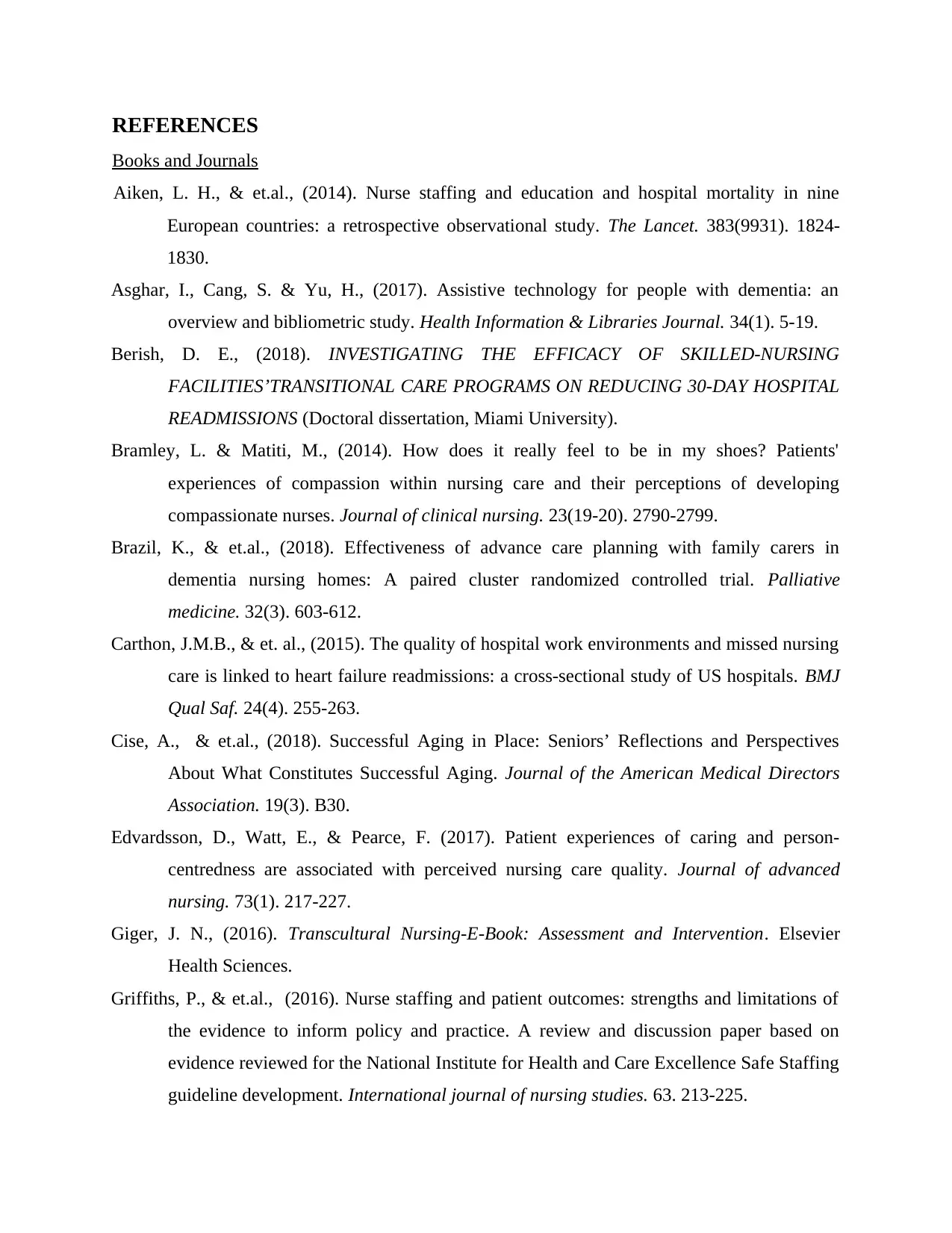
REFERENCES
Books and Journals
Aiken, L. H., & et.al., (2014). Nurse staffing and education and hospital mortality in nine
European countries: a retrospective observational study. The Lancet. 383(9931). 1824-
1830.
Asghar, I., Cang, S. & Yu, H., (2017). Assistive technology for people with dementia: an
overview and bibliometric study. Health Information & Libraries Journal. 34(1). 5-19.
Berish, D. E., (2018). INVESTIGATING THE EFFICACY OF SKILLED-NURSING
FACILITIES’TRANSITIONAL CARE PROGRAMS ON REDUCING 30-DAY HOSPITAL
READMISSIONS (Doctoral dissertation, Miami University).
Bramley, L. & Matiti, M., (2014). How does it really feel to be in my shoes? Patients'
experiences of compassion within nursing care and their perceptions of developing
compassionate nurses. Journal of clinical nursing. 23(19-20). 2790-2799.
Brazil, K., & et.al., (2018). Effectiveness of advance care planning with family carers in
dementia nursing homes: A paired cluster randomized controlled trial. Palliative
medicine. 32(3). 603-612.
Carthon, J.M.B., & et. al., (2015). The quality of hospital work environments and missed nursing
care is linked to heart failure readmissions: a cross-sectional study of US hospitals. BMJ
Qual Saf. 24(4). 255-263.
Cise, A., & et.al., (2018). Successful Aging in Place: Seniors’ Reflections and Perspectives
About What Constitutes Successful Aging. Journal of the American Medical Directors
Association. 19(3). B30.
Edvardsson, D., Watt, E., & Pearce, F. (2017). Patient experiences of caring and person‐
centredness are associated with perceived nursing care quality. Journal of advanced
nursing. 73(1). 217-227.
Giger, J. N., (2016). Transcultural Nursing-E-Book: Assessment and Intervention. Elsevier
Health Sciences.
Griffiths, P., & et.al., (2016). Nurse staffing and patient outcomes: strengths and limitations of
the evidence to inform policy and practice. A review and discussion paper based on
evidence reviewed for the National Institute for Health and Care Excellence Safe Staffing
guideline development. International journal of nursing studies. 63. 213-225.
Books and Journals
Aiken, L. H., & et.al., (2014). Nurse staffing and education and hospital mortality in nine
European countries: a retrospective observational study. The Lancet. 383(9931). 1824-
1830.
Asghar, I., Cang, S. & Yu, H., (2017). Assistive technology for people with dementia: an
overview and bibliometric study. Health Information & Libraries Journal. 34(1). 5-19.
Berish, D. E., (2018). INVESTIGATING THE EFFICACY OF SKILLED-NURSING
FACILITIES’TRANSITIONAL CARE PROGRAMS ON REDUCING 30-DAY HOSPITAL
READMISSIONS (Doctoral dissertation, Miami University).
Bramley, L. & Matiti, M., (2014). How does it really feel to be in my shoes? Patients'
experiences of compassion within nursing care and their perceptions of developing
compassionate nurses. Journal of clinical nursing. 23(19-20). 2790-2799.
Brazil, K., & et.al., (2018). Effectiveness of advance care planning with family carers in
dementia nursing homes: A paired cluster randomized controlled trial. Palliative
medicine. 32(3). 603-612.
Carthon, J.M.B., & et. al., (2015). The quality of hospital work environments and missed nursing
care is linked to heart failure readmissions: a cross-sectional study of US hospitals. BMJ
Qual Saf. 24(4). 255-263.
Cise, A., & et.al., (2018). Successful Aging in Place: Seniors’ Reflections and Perspectives
About What Constitutes Successful Aging. Journal of the American Medical Directors
Association. 19(3). B30.
Edvardsson, D., Watt, E., & Pearce, F. (2017). Patient experiences of caring and person‐
centredness are associated with perceived nursing care quality. Journal of advanced
nursing. 73(1). 217-227.
Giger, J. N., (2016). Transcultural Nursing-E-Book: Assessment and Intervention. Elsevier
Health Sciences.
Griffiths, P., & et.al., (2016). Nurse staffing and patient outcomes: strengths and limitations of
the evidence to inform policy and practice. A review and discussion paper based on
evidence reviewed for the National Institute for Health and Care Excellence Safe Staffing
guideline development. International journal of nursing studies. 63. 213-225.
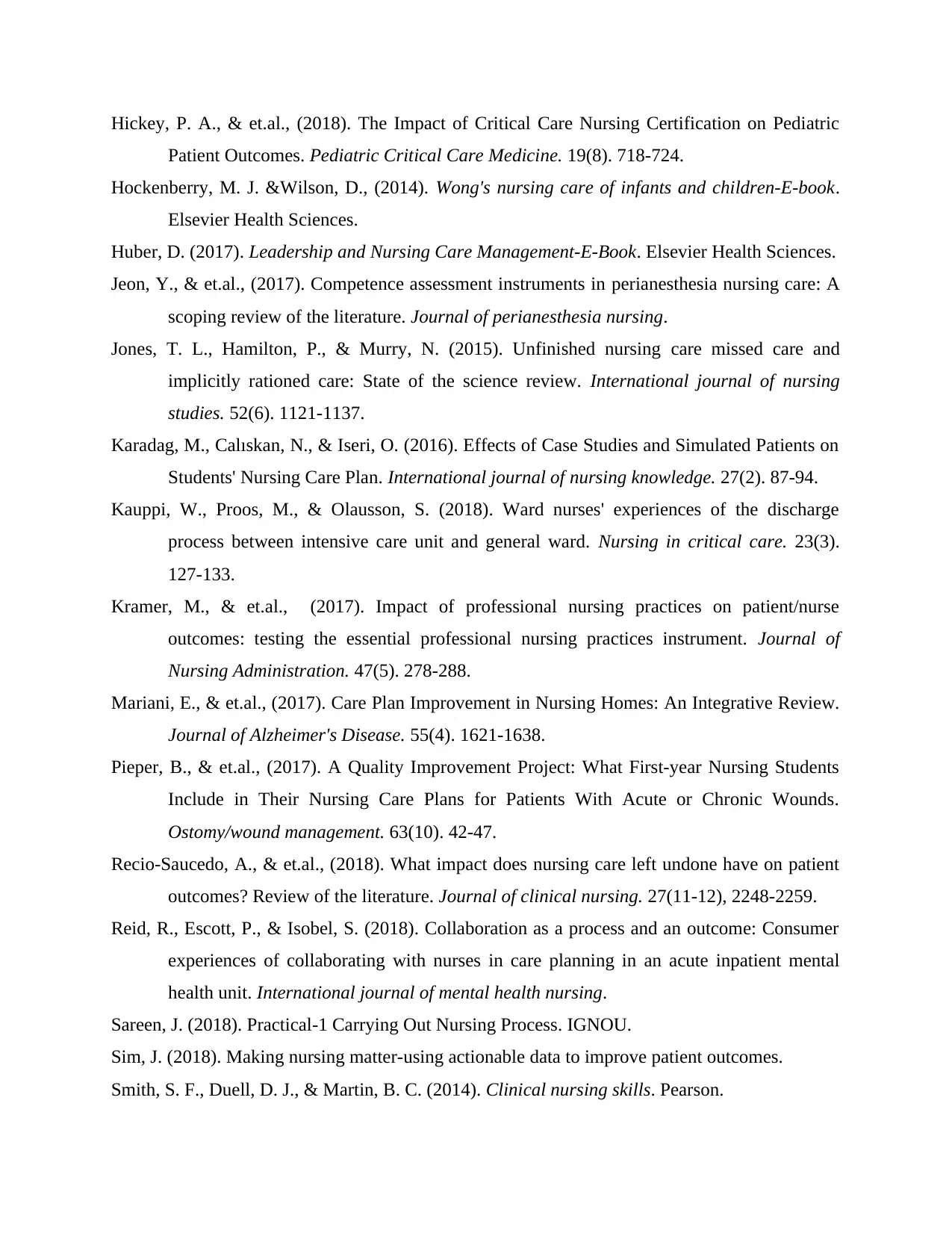
Hickey, P. A., & et.al., (2018). The Impact of Critical Care Nursing Certification on Pediatric
Patient Outcomes. Pediatric Critical Care Medicine. 19(8). 718-724.
Hockenberry, M. J. &Wilson, D., (2014). Wong's nursing care of infants and children-E-book.
Elsevier Health Sciences.
Huber, D. (2017). Leadership and Nursing Care Management-E-Book. Elsevier Health Sciences.
Jeon, Y., & et.al., (2017). Competence assessment instruments in perianesthesia nursing care: A
scoping review of the literature. Journal of perianesthesia nursing.
Jones, T. L., Hamilton, P., & Murry, N. (2015). Unfinished nursing care missed care and
implicitly rationed care: State of the science review. International journal of nursing
studies. 52(6). 1121-1137.
Karadag, M., Calıskan, N., & Iseri, O. (2016). Effects of Case Studies and Simulated Patients on
Students' Nursing Care Plan. International journal of nursing knowledge. 27(2). 87-94.
Kauppi, W., Proos, M., & Olausson, S. (2018). Ward nurses' experiences of the discharge
process between intensive care unit and general ward. Nursing in critical care. 23(3).
127-133.
Kramer, M., & et.al., (2017). Impact of professional nursing practices on patient/nurse
outcomes: testing the essential professional nursing practices instrument. Journal of
Nursing Administration. 47(5). 278-288.
Mariani, E., & et.al., (2017). Care Plan Improvement in Nursing Homes: An Integrative Review.
Journal of Alzheimer's Disease. 55(4). 1621-1638.
Pieper, B., & et.al., (2017). A Quality Improvement Project: What First-year Nursing Students
Include in Their Nursing Care Plans for Patients With Acute or Chronic Wounds.
Ostomy/wound management. 63(10). 42-47.
Recio‐Saucedo, A., & et.al., (2018). What impact does nursing care left undone have on patient
outcomes? Review of the literature. Journal of clinical nursing. 27(11-12), 2248-2259.
Reid, R., Escott, P., & Isobel, S. (2018). Collaboration as a process and an outcome: Consumer
experiences of collaborating with nurses in care planning in an acute inpatient mental
health unit. International journal of mental health nursing.
Sareen, J. (2018). Practical-1 Carrying Out Nursing Process. IGNOU.
Sim, J. (2018). Making nursing matter-using actionable data to improve patient outcomes.
Smith, S. F., Duell, D. J., & Martin, B. C. (2014). Clinical nursing skills. Pearson.
Patient Outcomes. Pediatric Critical Care Medicine. 19(8). 718-724.
Hockenberry, M. J. &Wilson, D., (2014). Wong's nursing care of infants and children-E-book.
Elsevier Health Sciences.
Huber, D. (2017). Leadership and Nursing Care Management-E-Book. Elsevier Health Sciences.
Jeon, Y., & et.al., (2017). Competence assessment instruments in perianesthesia nursing care: A
scoping review of the literature. Journal of perianesthesia nursing.
Jones, T. L., Hamilton, P., & Murry, N. (2015). Unfinished nursing care missed care and
implicitly rationed care: State of the science review. International journal of nursing
studies. 52(6). 1121-1137.
Karadag, M., Calıskan, N., & Iseri, O. (2016). Effects of Case Studies and Simulated Patients on
Students' Nursing Care Plan. International journal of nursing knowledge. 27(2). 87-94.
Kauppi, W., Proos, M., & Olausson, S. (2018). Ward nurses' experiences of the discharge
process between intensive care unit and general ward. Nursing in critical care. 23(3).
127-133.
Kramer, M., & et.al., (2017). Impact of professional nursing practices on patient/nurse
outcomes: testing the essential professional nursing practices instrument. Journal of
Nursing Administration. 47(5). 278-288.
Mariani, E., & et.al., (2017). Care Plan Improvement in Nursing Homes: An Integrative Review.
Journal of Alzheimer's Disease. 55(4). 1621-1638.
Pieper, B., & et.al., (2017). A Quality Improvement Project: What First-year Nursing Students
Include in Their Nursing Care Plans for Patients With Acute or Chronic Wounds.
Ostomy/wound management. 63(10). 42-47.
Recio‐Saucedo, A., & et.al., (2018). What impact does nursing care left undone have on patient
outcomes? Review of the literature. Journal of clinical nursing. 27(11-12), 2248-2259.
Reid, R., Escott, P., & Isobel, S. (2018). Collaboration as a process and an outcome: Consumer
experiences of collaborating with nurses in care planning in an acute inpatient mental
health unit. International journal of mental health nursing.
Sareen, J. (2018). Practical-1 Carrying Out Nursing Process. IGNOU.
Sim, J. (2018). Making nursing matter-using actionable data to improve patient outcomes.
Smith, S. F., Duell, D. J., & Martin, B. C. (2014). Clinical nursing skills. Pearson.
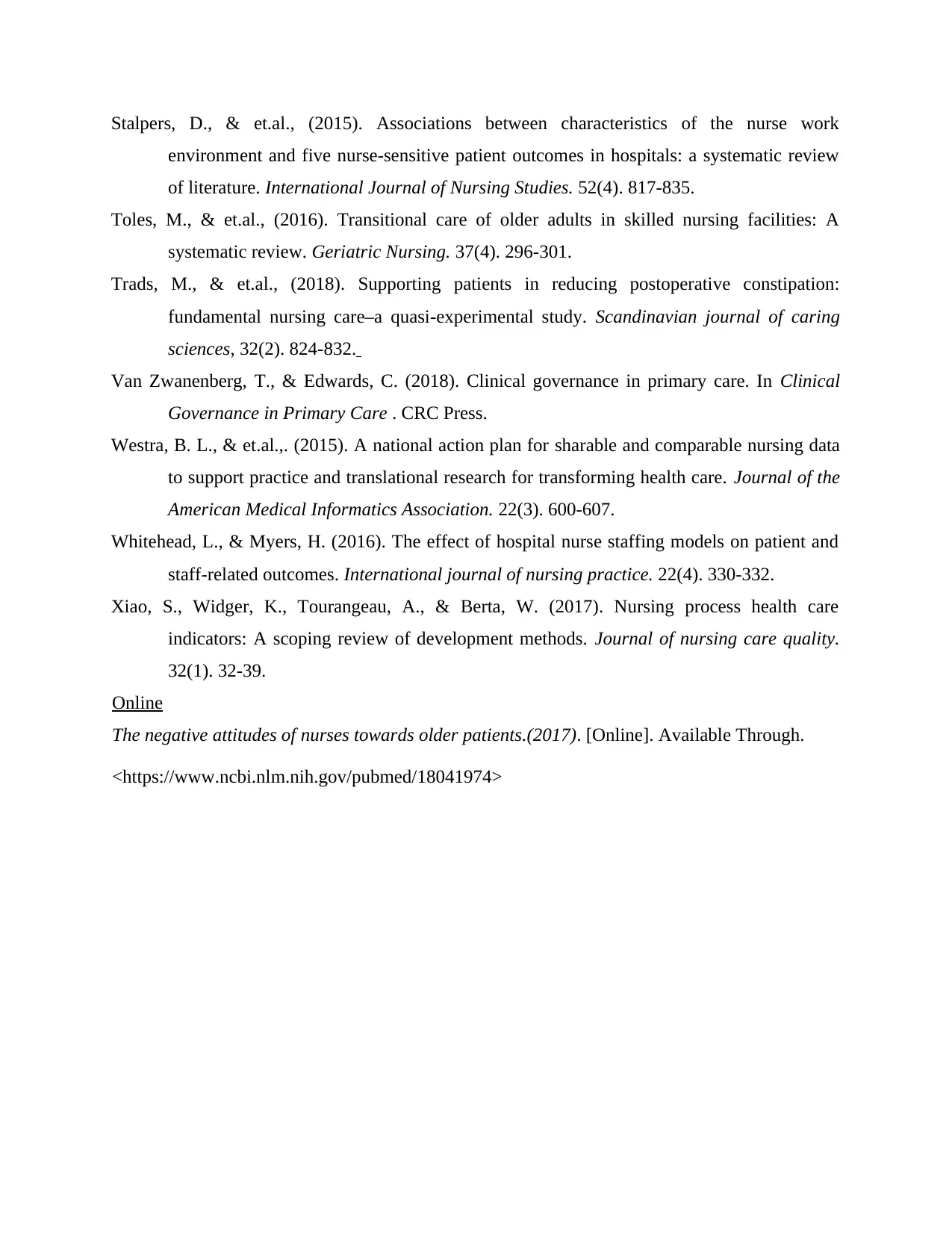
Stalpers, D., & et.al., (2015). Associations between characteristics of the nurse work
environment and five nurse-sensitive patient outcomes in hospitals: a systematic review
of literature. International Journal of Nursing Studies. 52(4). 817-835.
Toles, M., & et.al., (2016). Transitional care of older adults in skilled nursing facilities: A
systematic review. Geriatric Nursing. 37(4). 296-301.
Trads, M., & et.al., (2018). Supporting patients in reducing postoperative constipation:
fundamental nursing care–a quasi‐experimental study. Scandinavian journal of caring
sciences, 32(2). 824-832.
Van Zwanenberg, T., & Edwards, C. (2018). Clinical governance in primary care. In Clinical
Governance in Primary Care . CRC Press.
Westra, B. L., & et.al.,. (2015). A national action plan for sharable and comparable nursing data
to support practice and translational research for transforming health care. Journal of the
American Medical Informatics Association. 22(3). 600-607.
Whitehead, L., & Myers, H. (2016). The effect of hospital nurse staffing models on patient and
staff‐related outcomes. International journal of nursing practice. 22(4). 330-332.
Xiao, S., Widger, K., Tourangeau, A., & Berta, W. (2017). Nursing process health care
indicators: A scoping review of development methods. Journal of nursing care quality.
32(1). 32-39.
Online
The negative attitudes of nurses towards older patients.(2017). [Online]. Available Through.
<https://www.ncbi.nlm.nih.gov/pubmed/18041974>
environment and five nurse-sensitive patient outcomes in hospitals: a systematic review
of literature. International Journal of Nursing Studies. 52(4). 817-835.
Toles, M., & et.al., (2016). Transitional care of older adults in skilled nursing facilities: A
systematic review. Geriatric Nursing. 37(4). 296-301.
Trads, M., & et.al., (2018). Supporting patients in reducing postoperative constipation:
fundamental nursing care–a quasi‐experimental study. Scandinavian journal of caring
sciences, 32(2). 824-832.
Van Zwanenberg, T., & Edwards, C. (2018). Clinical governance in primary care. In Clinical
Governance in Primary Care . CRC Press.
Westra, B. L., & et.al.,. (2015). A national action plan for sharable and comparable nursing data
to support practice and translational research for transforming health care. Journal of the
American Medical Informatics Association. 22(3). 600-607.
Whitehead, L., & Myers, H. (2016). The effect of hospital nurse staffing models on patient and
staff‐related outcomes. International journal of nursing practice. 22(4). 330-332.
Xiao, S., Widger, K., Tourangeau, A., & Berta, W. (2017). Nursing process health care
indicators: A scoping review of development methods. Journal of nursing care quality.
32(1). 32-39.
Online
The negative attitudes of nurses towards older patients.(2017). [Online]. Available Through.
<https://www.ncbi.nlm.nih.gov/pubmed/18041974>
1 out of 13
Related Documents
Your All-in-One AI-Powered Toolkit for Academic Success.
+13062052269
info@desklib.com
Available 24*7 on WhatsApp / Email
![[object Object]](/_next/static/media/star-bottom.7253800d.svg)
Unlock your academic potential
© 2024 | Zucol Services PVT LTD | All rights reserved.





